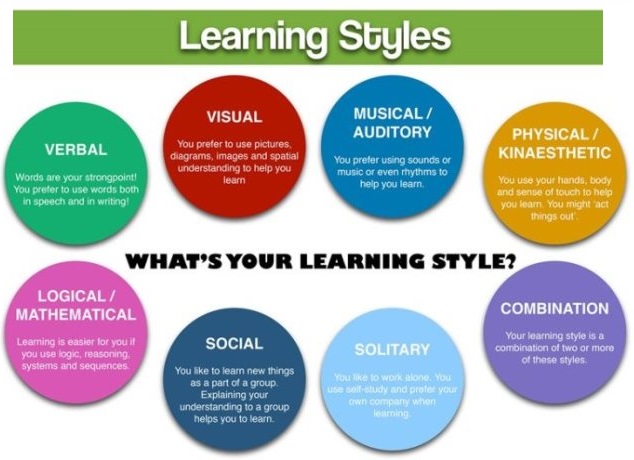
Not everybody process information in a similar pattern. Especially among kids, information processing is different and not necessarily the same as how you and I do it. Some process information through sight, some by sound or touch etc. When learning is done using the above mentioned different approaches, it is called as learning styles.
GET INSTANT HELP FROM EXPERTS!
- Looking for any kind of help on your academic work (essay, assignment, project)?
- Want us to review, proofread or tidy up your work?
- Want a helping hand so that you can focus on the more important tasks?
Hire us as project guide/assistant. Contact us for more information

Learning styles are very important to understand the different approaches of Learning styles. But before you head there, you should try to understand your child’s preference of learning for a better teaching and learning experience for both you and your child.
Types of Learning Styles
Learning styles can be broadly categorized into these four types (there are a few more types though):
- Visual Learner
- Auditory Learner
- Read/Write Learner
- Kinesthetic /Tactile Learner
The above styles are based on Neil Flemings VAK/VARK model. Understanding these styles will definitely give you deeper insight into your child’s learning and progress. You may have wondered why your child does not understand things when you explain it to him or why your child better understands one particular teachers compared to others etc. Learning styles will help you answer some or most of these questions.
We take pride in our children when they do something smart and brilliant at a young age, but when we see the same child struggle with learning as they grow up, it throws up a lot of questions. We question ourselves and our teaching ability even. With learning styles you can ensure that your child learns and understands everything with relative ease and also enjoy the whole learning experience.
Curiosity and Learning
They say, a wise man can learn more from the foolish questions than a fool can learn from the wise answers. For a person to fully evolve, grow and groom ,one has to pursue the human quality of being curious. As, “ Curiosity is the mother of all sciences.” When one is curious about something or everything, learning becomes easier. By following your curiosity, pursuing meaningful challenges, you can experience new levels of joy and fulfillment, at any age and any given point in time.
Remember the annoying aunties, uncles and teachers who pour the cold water on your eager questioning ? , saying “ curiosity killed a cat!” Fortunately , many regard curiosity as the strength of human development even in the ‘Grades obsessed’ culture of ours.
Children having high levels of curiosity are found experiencing higher levels of satisfaction with life and greater success as adults . It’s surprising, that the person who said, “ I have no special talents. I am only passionately curious.” was Albert Einstein.
Curiosity is defined as, taking interest in all of the ongoing experiences, finding all subjects and topics fascinating and exploring and discovering. Being curious by nature ,is associated with creativity ,intelligence, problem-solving ability and willingness to know more and keeping oneself updated. Its also correlated with positivity, optimism,personal well-being, better long term health and interpersonal relationships in a positive equation.
It all beings with the mind being always cloudy ,buzzing questions ,a urge to investigate, to enquire, a constant urge to seek answers to several questions ,willingness to develop conclusions about the self and for the self ,the readiness to ask and find out despite knowing and considering the possibility of hitting the blank wall, the hope to dwell into the virtual Lala land after seeking desired answers or to dwell in the creepy thoughts in case of the undesirable findings.
It all begins when one realizes that, “I don’t know something” and its natural of the human intelligence to seek that and therefore we love to know answers of something that are not even necessary. The basis of curiosity is thus the realization that, “I don’t know”. The more we realize, we do not know, more is the longing to know.
But curiosity works in two ways,the same urge that drives the curious people to pursue the multiple interests may also lead them to disregard the danger or get into hazardous activities. Still, the enrichment that curious people experience generally overweighs the negative effects of the risk they take.
Travelling, especially is the best way to keep curiosity alive. But for this, one needs to be committed traveler with an open mind, to refuse to find faults ,develop on sense of humor , and try new things.
Thus life for a curious person, is continuously being hungry, the meaning of life is not simply to exist to survive ,but to move ahead ,to discover ,to explore and achieve to conquer, as – “Millions saw the apple fall, but Newton asked why”
StudyMumbai.com is an educational resource for students, parents, and teachers, with special focus on Mumbai. Our staff includes educators with several years of experience. Our mission is to simplify learning and to provide free education. Read more about us.

Leave a Reply
You must be logged in to post a comment.